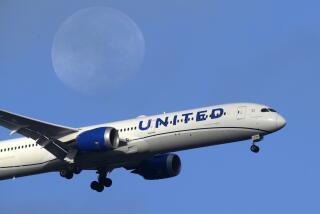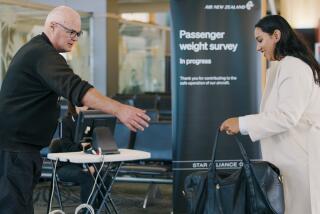Taking a ride on a ‘perfect flight’
- Share via
SAN FRANCISCO — New Zealanders showed the Federal Aviation Administration a thing or two Friday about flying into the future.
Using new technologies and procedures on a flight from Auckland, Air New Zealand cut waiting time, trimmed flying time, saved 1,200 gallons of fuel, eliminated 30,000 pounds of harmful carbon emissions and took a quieter approach on arrival at San Francisco International Airport.
The flight could mark the first major step in altering the way airlines operate their planes, FAA and Air New Zealand representatives said.
“Today is just a great day for aviation,” said Robert Sturgell, the FAA’s acting administrator, who was on hand to greet the arrival of the regularly scheduled flight. “Clearly we’re headed in the right direction.”
Although the changes were little noticed by the 270 passengers on board, the flight had actually set a milestone in aviation as it flew what Air New Zealand executives unabashedly called the “perfect flight.”
In reality, airline and FAA representatives had been planning the flight for months, giving it ideal conditions to save fuel, including giving the plane priority takeoff and landing so it could try the new procedures.
Still, FAA and airline spokesmen lauded the results, which would be used as a benchmark for other carriers.
“All in all it was a very successful flight,” David Morgan, the airline’s general manager for operations and safety who spearheaded the initiative, said shortly after the plane landed about 10 minutes ahead of schedule. “It exceeded our expectations.”
Some results were not all that noteworthy. The airline had hoped to slash the time even more, but the importance of saving fuel outweighed that of reducing travel time because the plane was diverted twice during the flight to avoid turbulence and unfavorable weather conditions.
Most passengers lauded the initiative, but some also asked whether the cost savings would translate into lower fares.
“It’s quite a good thing to save fuel, isn’t it?” said Hayley Warren, who was traveling with her husband and four children from Auckland to attend a wedding in New York.
But she asked, “If other airlines do this thing, will it bring down the price for passengers?”
Airline representatives weren’t sure whether airfares would be affected, especially if oil prices begin climbing again. But Morgan said that with the industry facing billions of dollars in losses this year, the latest initiative was “designed to help the airlines get to a more sustainable footing.”
Although fuel savings became a larger goal, the flight was initially intended to demonstrate how airlines could cut carbon dioxide emissions.
Airliners contribute about 3% of the world’s carbon emissions, but some scientists believe that emissions from planes are more harmful because they occur higher up in the atmosphere.
The flight was formally dubbed Aspire One, after the name of the partnership -- Asia and South Pacific Initiative to Reduce Emissions -- but unofficially it was called the “perfect flight” to reflect Air New Zealand’s ambition to operate the most efficient flight possible.
The airline has been at the forefront of finding new ways of making flights more environmentally friendly and fuel efficient. In December, Air New Zealand plans to fly a Boeing 747 jumbo jet partially powered by fuel refined from the seeds of the jatropha, a type of fast-growing weed.
The airline’s environmental efforts are “consistent with what motivates people to come to New Zealand,” Chief Executive Rob Fyfe said.
For the FAA, Friday’s flight was a boost for its multibillion-dollar effort to modernize air-traffic control. It has been stalled in Congress, where lawmakers have questioned the ambitious plan that includes setting up an advanced satellite-based air-traffic-control system.
In an interview Friday, the FAA’s Sturgell said the flight helped show that parts of the modernization effort were already in place. “You can see the results. You can show it’s here today. That’s what Congress wants to see.”
For instance, the flight used satellite-based communications to get up-to-date weather reports that were used to divert the flight to a more fuel-efficient path.
At Auckland, the demonstration flight officially kicked off about 15 minutes before departure as Morgan got on the plane’s public-address system and disclosed to unsuspecting passengers that they were part of a test flight.
For Friday’s flight, the ground crew waited until 20 minutes before departure, under a new “just in time fueling” procedure, to top off the plane’s fuel tank. This way, the amount of fuel would be based closer to the actual passenger load, which showed that the plane was 1,800 pounds lighter than expected and didn’t need as much fuel as initially estimated.
As passengers began boarding, the aircraft relied on the airport’s electrical power instead of its own auxiliary power unit to save fuel. Most planes sitting at the gate waiting for passengers to board use the unit to power up the plane.
About 3 1/2 hours into the flight, as most passengers began falling asleep, the plane made a slight shift of about 100 miles to the east after receiving an updated weather and wind report via satellite. With the exception of the pilot, no one on the plane was aware that the flight path had been changed.
A second weather update about six hours later, as the plane neared the Hawaiian Islands, prompted the pilot to adjust the plane’s path once more.
Normally, airliners follow a predetermined route planned before takeoff. As a result, the flight path can differ significantly from the shortest route possible between two points on the globe. Following the so-called great circle is considered an ideal route for time and fuel savings.
As the plane approached San Francisco, it began a gradual descent that was smoother and quieter than usual. It followed a “tailored approach,” in which air-traffic controllers worked with the airline to have the plane descend in a straight line, as though it were on cruise control, without having to throttle the jet engines up and down to follow the typical “step-down” landing pattern.
The FAA hopes to implement the landing procedure at Los Angeles International Airport next year. The FAA said the continuous descent approach could reduce noise by 30% at LAX, helping to address complaints from people living near the airport.
The fuel savings of 1,200 gallons was relatively small considering that the plane used 27,700 gallons, but Air New Zealand CEO Fyfe touted the wider potential of airlines’ adopting some of the techniques demonstrated in Friday’s flight.
“This is no PR stunt,” said Fyfe, speaking before the flight, which he did not take. “When you start multiplying the savings just across our own network of flights and then apply that to other airlines, you get the real sense of the potential for cutting millions of tons of fuel and carbon dioxide emissions.”
--
More to Read
Inside the business of entertainment
The Wide Shot brings you news, analysis and insights on everything from streaming wars to production — and what it all means for the future.
You may occasionally receive promotional content from the Los Angeles Times.










